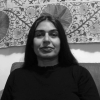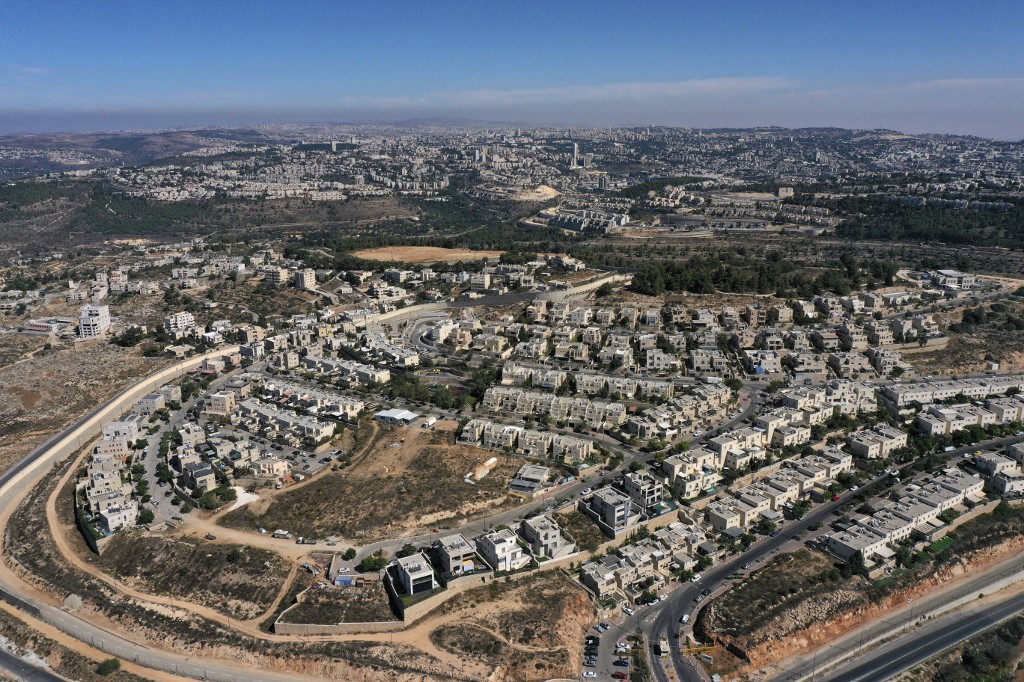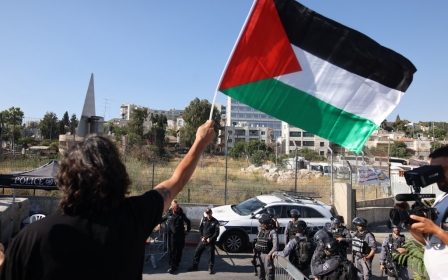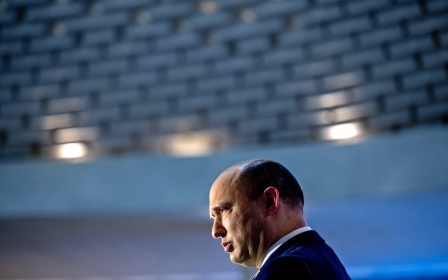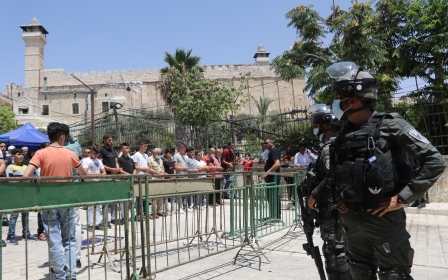To celebrate Hanukkah, Herzog takes a tour of Palestinian suffering

Israeli President Isaac Herzog lit this year's first Hanukkah candle at the Tomb of the Patriarchs in Hebron. There, at the symbolic epicentre of Israeli apartheid, some 500 Jewish settlers in an enclave within a Palestinian city of some 215,000 souls terrorise their neighbours daily, as the occupying army looks on.
Nearby is Shuhada Street, the city's former commercial centre, its shops shuttered long ago. Palestinians have been forbidden access since Baruch Goldstein's 1994 massacre of Muslim worshippers at the very site where Herzog last weekend celebrated the triumph of the Hasmoneans over the Greeks, which in Jewish culture symbolises the victory of the righteous few over the oppressive many.
In a society that has transformed the right to oppress and crush another people into a consensus, unity is a dangerous value
The office of the presidency in Israel is symbolic, serving primarily as a professional graveyard for failed politicians. Herzog, a mediocre political figure who once led the Labor Party and later lost that position to Avi Gabbay, another mediocre politician, became president thanks to a dearth of serious competition: the other main contender was Miriam Peretz, whose chief public credential is as a bereaved mother of two soldier sons. Undoubtedly Herzog was also helped by being the son of Chaim Herzog, the sixth president of Israel.
Thanks to the younger Herzog's Labor background, leftist Zionists cherished certain hopes when he won the presidency, but they were quickly disappointed.
Upon Herzog's announcement that he would light the first Hanukkah candle in Hebron, a rebuke came promptly from the left-wing Meretz party, stressing that the president should be a "unifying figure," a peculiar note, given the remote prospects of finding anything more unifying for Israel's Jewish majority than its comprehensive acquiescence in a regime of Jewish supremacy, with Hebron as its purest manifestation.
The right to oppress
In a society that has transformed the right to oppress and crush another people into a consensus, unity is a dangerous value, and certainly not some essential dynamic to be sanctified. More appropriate would be to promote justice, equality and liberty - all the values being trampled upon daily in Hebron.
Along the usual route from Jerusalem to Hebron, Herzog would have been confronted on all sides by the injustice, robbery and pervading evil his visit could not help but normalise.
Leaving the presidential residence in Jerusalem, his motorcade would have taken the Begin Highway southbound. This road and its connections north and south are part of a sophisticated transportation system designed to de facto erase the Green Line (for Israeli citizens, of course), whether within or outside of Jerusalem's municipal boundaries.
Herzog's route would have proceeded to the so-called Tunnel Road, so designated because of two tunnels, currently undergoing massive renovation, with a bridge connecting them. The land involved, like the land on which the Gilo settlement (with a population of around 30,000) was built, was seized from Beit Jala, just as land was seized from Sharfat and Beit Safafa, and other Palestinian towns, for a similar purpose.
Between the two tunnels, Herzog's car would have proceeded onto a high bridge, from where he might have seen the Har Gilo settlement, built in the 1970s on lands seized "temporarily" for "security reasons" from residents of Beit Jala. Har Gilo today is a bourgeois, secular settlement affording no hint of abandoning its "temporary" location when the "security reasons" no longer apply.
Soon afterwards, Herzog would have transited a security checkpoint that is functionally a one-way affair: the only vehicles stopped and checked are those entering the municipal territory of Jerusalem, based on boundaries adopted unilaterally in 1967.
Beyond that checkpoint, he would have seen the Neve Ori outpost, a homestead erected about two-and-a-half years ago, whose residents have since tried to take over new acreage while menacing their Palestinian neighbours in one of the most beautiful agricultural areas in the Bethlehem district. From there, Herzog would have continued without hindrance southward to the Gush Etzion settlement bloc.
Settlements and outposts
At this juncture, we must apologise to His Excellency the president for the unpleasantness involved in the fact that he would now have to travel a few kilometres on a two-lane road paved in the mid-1990s, which just a year or so ago was widened. He would have seen on his right the illegal outpost of Sde Boaz, and on his left the separation wall built along the Bethlehem bypass road.
A bit further on, he would have seen the southern entrance to Bethlehem, which also serves as the northern entrance to the Efrat settlement and al-Nashash checkpoint. Israel can close the checkpoint arbitrarily whenever it wants to, thereby cutting off intercity traffic between Bethlehem and Hebron. From there, Herzog would have been able to see Efrat on the ridge to his east, heralding a series of religious settlements and outposts to follow.
About a kilometre past the southern entrance to Efrat he would have come to the Gush (Etzion) Junction, a roundabout that to the west leads to the settlements of Alon Shvut, Rosh Tzurim, Kfar Etzion and Gevaot, and from there descends to the Jaba checkpoint and the Green Line.
Proceeding straight ahead southward, Herzog would have seen a major roadworks project for the new al-Arub bypass road, one of two large bypass arteries Israel is currently constructing in the occupied West Bank to connect Kiryat Arba and all the settlements of the South Hebron Hills with Jerusalem, eliminating the need to pass through Arab cities and towns.
Continuing southward, Herzog would have seen to his left the al-Arub refugee camp, whose residents lost land to projects for Jewish residents that included, among other things, the Kiryat Gat industrial park, the new village of Zacharia and Kiryat Malachi. To his right, he would have seen a huge military guard tower that sits directly across from the refugee camp.
Herzog would have passed the Palestinian village of Beit Ummar and come to another enormous military guard tower, after which he would have seen the entrance to Karmei Tzur, a violently extremist settlement that was home to, among others, the murderer of the Dawabsheh family.
Nation of overlords
Beyond that, a large yellow barrier marks the entrance to the Palestinian city of Halhul in Area A, which the president could not possibly have entered by accident, thanks to the giant red sign warning Israelis against entering Palestinian towns. Along the Halhul bypass road he would have seen beautiful vineyards on both sides, gorgeously arrayed in their autumn foliage. He would have passed agricultural terraces thousands of years old and continued on towards Hebron.
Herzog would have transited through the settlement of Kiryat Arba and emerged in the eastern part of Hebron. There, in the H2 area controlled by Israel, Herzog would have reached the Tomb of the Patriarchs.
His route would not have actually taken him through the settlements and outposts of the South Hebron Hills, the points of origin for endless pogroms and violent attacks on Palestinian residents
His route would not have actually taken him through the settlements and outposts of the South Hebron Hills, the points of origin for endless pogroms and violent attacks on Palestinian residents of the area. It is certainly possible, however, that his hosts would have proposed that he come again sometime for a somewhat altered tour, affording him more exposure to the iniquities perpetrated by the nation of overlords over which he presides.
We can only be thankful that Herzog decided to make do with lighting a Hanukkah candle at the Tomb of the Patriarchs, without announcing his intention to also read the Scroll of Esther on the anniversary of the massacre there during Purim. But who knows, Purim is still two-and-a-half months away, so arrangements could still be made. His hosts - Itamar Ben-Gvir, Noam Federman, Baruch Marzel and Benzion Gopstein, the Kahanists from Kiryat Arba and Hebron - would be only too glad to welcome him again.
- Dror Etkes assisted in the research for this article
The views expressed in this article belong to the author and do not necessarily reflect the editorial policy of Middle East Eye.
Middle East Eye propose une couverture et une analyse indépendantes et incomparables du Moyen-Orient, de l’Afrique du Nord et d’autres régions du monde. Pour en savoir plus sur la reprise de ce contenu et les frais qui s’appliquent, veuillez remplir ce formulaire [en anglais]. Pour en savoir plus sur MEE, cliquez ici [en anglais].


